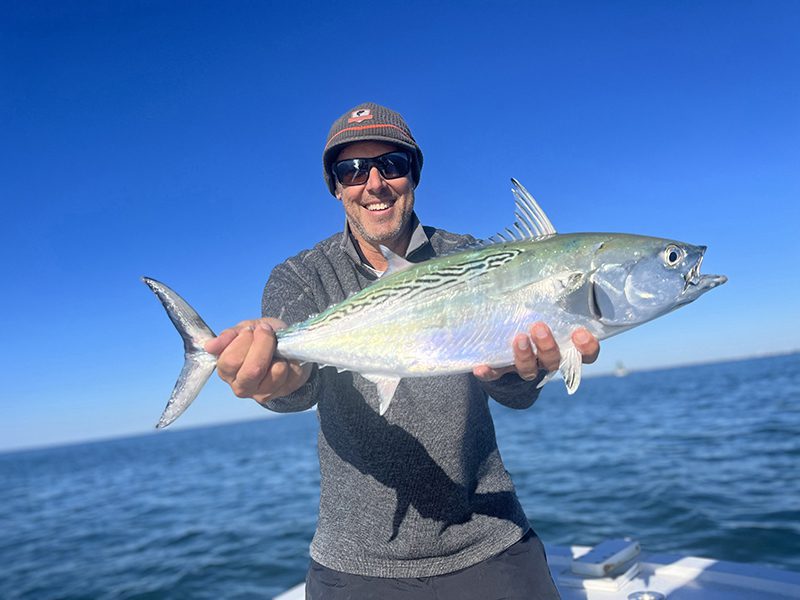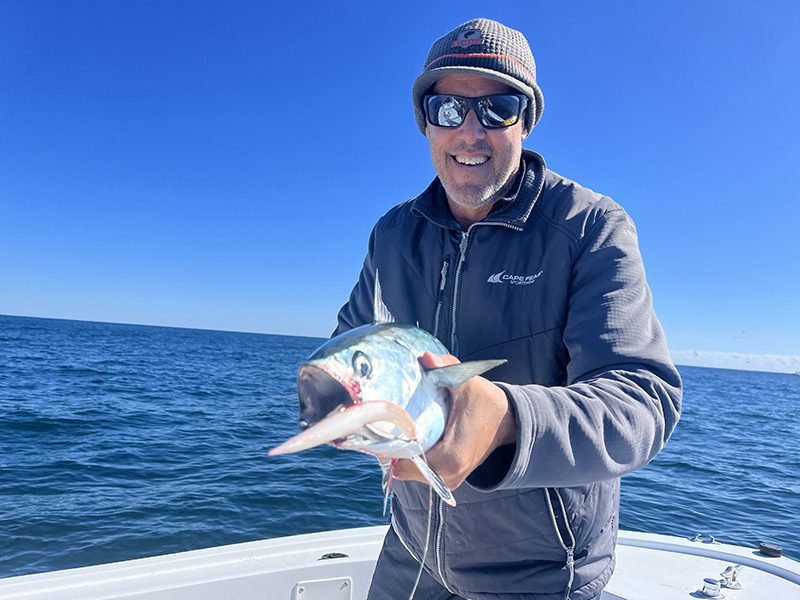Tidelines – November 2022
There are several markers that the fall fishing season is finally underway, and while speckled trout for most take center stage, I’m more than happy to chase false albacore in October and early November while the late fall and winter trout bite is still transitioning and developing.
False albacore appear up and down the NC coast, but to really kick off the season, I’m a fan of targeting the iconic Cape Lookout area outside of Beaufort Inlet. And I’m an even bigger fan of cruising those waters and looking for birds and fish splashes with Capt. Andy Bates of Captain Bate’s Guide Service out of Morehead and Beaufort.
Andy texted me to meet at the public boat ramp beside Town Creek Marina at 7:30 am, but then offered that we could also meet later since I was driving up from Wilmington and there was no big need to get on the water early for albacore fishing.
“Once that sun gets up and you can see birds further away and see splashes further away,” he explained to me as we made our way through the No Wake zone leading to the inlet at around 8:30 am, “you’re a little more effective on your rod.”
The Atlantic had little wind, little waves, and lots of visibility, and while we saw some bird activity immediately about a mile out and just off the tide line, we didn’t see the amount of bird activity Andy was hoping for.

Gary Hurley, of Fisherman’s Post, with one of the 7-8 lb. albacores he hooked off a tide line out of Beaufort Inlet. He was fishing with Capt. Andy Bates of Captain Bates Guide Service.
Birds would gather, and they would dive down on the fish splashes that would appear under them, but everything was sporadic and scattered.
Andy took to the binoculars resting on the console and thought out loud to me, “We need the fish to knot up a little bit more and stay up just a little bit longer and be a little more consistent.”
We weren’t yet in a “whack-a-mole” situation, as we were getting some chances at fish. We just weren’t getting any prolonged chances at fish. I saw Andy eyeing a gaggle of birds off in the distance and asked him how he calculates staying in an area where you saw fish versus running a ways to a new area where you see active fish.
“It’s always a fine line between being patient and being hard headed,” Andy said. “A lot of it is just reading the bird activity, looking in the binoculars, and if you’re seeing something way off far knotting with a lot of splashing, and where you’re at you haven’t seen anything for five minutes, then it’s worth a run to check it out.”
He decided to run.
The first knot of fish Andy had seen off in the distance had sounded before we arrived, but soon enough another pocket of fish appeared. This pocket seemed to represent not only more active fish, but longer lasting activity as well.
Up in the bow, I did exactly what Andy had told me to do. I threw my white Albie Snax just past the activity, quickly flipped the bail, kept my rod at a 45-degree angle, and ripped the soft plastic back to me as fast as I could reel so as to keep the bait skipping across the water’s surface.
“When the fish are a little more finicky,” Andy had told me earlier in the morning, “instead of trying to match the size or the exact bait they’re feeding on, we can go with an Albie Snax. Ripping it across the surface creates more of a reaction bite.”
“Plus,” he added, “you get to see that reaction bite on the surface when the fish blow up on it.”
In addition to the Albie Snax, another strategy Andy uses when the fish are up and down is to have a second angler throw a metal jig. You make a long cast, let it sink to the bottom, and then rip it back all the way through the water column. The only problem, Andy explained, is that the metal jig will often find an undesirable bycatch, such as a bluefish or a spot or a gray trout or, as Andy did with his first cast of a metal jig, a croaker.

Gary Hurley holds up an albacore that fell for a white Albie Snax ripped across the water’s surface. He was casting to busting fish with Capt. Andy Bates of Captain Bates Guide Service out of the Morehead and Beaufort area.
We had new fish appear 30-35 yards off the starboard side, and I was quick to send the Albie Snax flying. My bait skipped beautifully through some splashes but with no attention. Just then a second pod of fish appeared about 20-30 feet off the bow and in the direction of my retrieve. My bait got closer, and the fish stayed up. My bait got right on top of the action, and the fish were still up. Then right when my bait started to leave the melee, I saw a silver flash crush the soft plastic and disappear, and I was tight to what would be a 7-8 lb. albacore.
Our albacore action continued on the tide line, and when it slowed we made our way to the east side of the Cape. We saw (and caught) more albacore, and we also were witness to some of the wonderful sights of the shoals: acres of bluefish that would swim under our boat looking like a school of pogies, a meandering school of lookdowns that didn’t seem to care at all that we were motoring closely by them, shark fins thrashing on pods of bait, and spinner sharks skying out.
A couple of Andy’s friends that were also on the east side had been following a school of big red drum, but since the red drum weren’t cooperating for the 3-4 boats already on the school, we figured adding another boat wouldn’t give us, or anyone, good odds.
The run back to the boat ramp gave us time to catch up on his son and baseball and my kids and soccer, among other conversations, and we planned to continue our fall albacore tradition next year.
What are your fall traditions? If you don’t yet have one that includes chasing and hunting hard-fighting, drag-pulling fish with the visual rewards of both busting fish and the smorgasbord of life around the shoals of Cape Lookout, then reach out to Capt. Andy Bates, of Captain Bates Guide Service. You can reach him at www.captainbates.com or at (252) 888-4868.
Tell him you want the Gary Hurley trip that includes running into Justin Ragsdale at the dock where Justin will then openly and loudly share his opinions on any topic you want.





